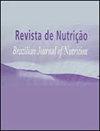住院儿童四种不同营养风险筛查工具的比较
IF 0.5
4区 医学
Q4 NUTRITION & DIETETICS
Revista De Nutricao-brazilian Journal of Nutrition
Pub Date : 2023-06-02
DOI:10.1590/1678-9865202336e220239
引用次数: 0
摘要
摘要目的:早期发现住院儿童营养不良风险可改善其健康结局和生活质量;然而,儿童筛查工具适用于土耳其儿童的研究数量有限。因此,本文旨在确定营养状况和生长风险筛查工具、儿科营养不良评估筛查工具、儿科约克希尔营养不良评分和简易儿科营养筛查工具(原始截止点和调整截止点)评估的儿科患者营养不良风险的普遍程度,并评估哪种儿科筛查工具适合土耳其儿童。方法:在本横断面研究中,采用四种已发表的营养风险筛查工具(营养状况和生长风险筛查工具、儿科营养不良评估筛查工具、儿科约克希尔营养不良评分工具、儿科营养筛查工具)对住院1个月至17岁、住院时间至少24小时的儿科住院患者(n=604)进行评估。结果:儿童营养筛查工具对急性营养不良的识别率最高(94.2%)。根据儿童约克希尔营养不良评分,营养风险较高与急性(营养状况和生长风险筛查工具的OR为6.57,儿科营养不良评估筛查工具的OR为5.84,儿童约克希尔营养不良评分的OR为20.35)和慢性营养不良(OR:营养状况和生长风险筛查工具为1.27,儿科营养不良评估筛查工具为3.28,儿科约克希尔营养不良评分为1.72)。通过儿科营养筛查工具对高危类别进行分类与营养不良的几率增加有关(OR:原始值为2.64,调整截止值为5.24)。急性(原始截止值OR: 4.07,调整截止值OR: 28.01)和慢性营养不良(原始截止值OR: 1.14,调整截止值OR: 1.67)也观察到这种正相关。结论:调整截止点的儿科营养筛查工具和儿科Yorkhill营养不良评分在评估住院土耳其儿童营养状况和发现儿童,特别是急性营养不良方面的诊断准确性高于其他筛查工具。本文章由计算机程序翻译,如有差异,请以英文原文为准。
Comparison of four different nutritional risk screening tools in hospitalized children
ABSTRACT Objective: Early detection of malnutrition risk in hospitalized children can improve health outcomes and quality of life; however, the number of studies where the pediatric screening tool is appropriate for Turkish children is limited. Therefore, this article aims to determine the prevalence of malnutrition risk in pediatric patients evaluated with Screening Tool for Risk on Nutritional Status and Growth, Screening Tool for the Assessment of Malnutrition in Pediatrics, Pediatric Yorkhill Malnutrition Score, and Simple Pediatric Nutrition Screening Tool with original and adjusted cutoffs and to evaluate which pediatric screening tool is appropriate for Turkish children. Methods: In this cross-sectional study, four published nutritional risk screening tools (Screening Tool for Risk on Nutritional Status and Growth, Screening Tool for the Assessment of Malnutrition in Pediatrics, Pediatric Yorkhill Malnutrition Score, Pediatric Nutrition Screening Tool) were applied to pediatric inpatients (n=604) aged 1 month to 17 years, admitted to a pediatric ward for at least 24 hours. Results: Pediatric Nutrition Screening Tool with adjusted cutoffs had the greatest recognition rate (94.2%) of acute malnutrition. Having a high nutritional risk by Pediatric Yorkhill Malnutrition Score was associated with an increased risk of acute (OR: 6.57 for Screening Tool for Risk on Nutritional Status and Growth, 5.84 for Screening Tool for the Assessment of Malnutrition in Pediatrics, and 20.35 for Pediatric Yorkhill Malnutrition Score) and chronic malnutrition (OR: 1.27 for Screening Tool for Risk on Nutritional Status and Growth, 3.28 for Screening Tool for the Assessment of Malnutrition in Pediatrics, and 1.72 for Pediatric Yorkhill Malnutrition Score). Classifying the at-risk category by the Pediatric Nutrition Screening Tool was related to raised odds of malnutrition (OR: 2.64 for original and 5.24 for adjusted cutoffs). This positive association was also observed for acute (OR: 4.07 for original cutoffs, and 28.01 for adjusted cutoffs) and chronic malnutrition (OR: 1.14 for original cutoffs, and 1.67 for adjusted cutoffs). Conclusion: Pediatric Nutrition Screening Tool with adjusted cutoffs and Pediatric Yorkhill Malnutrition Score have higher diagnostic accuracy than other screening tools in assessing the nutritional status of hospitalized Turkish children and detecting children, particularly with acute malnutrition.
求助全文
通过发布文献求助,成功后即可免费获取论文全文。
去求助
来源期刊
CiteScore
1.20
自引率
12.50%
发文量
24
审稿时长
6-12 weeks
期刊介绍:
Revista de Nutrição is former Revista de Nutrição da Puccamp, founded in 1988. It is a bimonthly publication every four months and it is of responsibility of the Centro de Ciências da Vida, da Pontifícia Universidade Católica de Campinas . It publishes articles that contribute to the study of Nutrition in its many sub-areas and interfaces; and is open to contributions of the national and international scientific communities.

 求助内容:
求助内容: 应助结果提醒方式:
应助结果提醒方式:


